Music Jim Steinman Composer Jim Steinman | First performance 4 October 1997 | |
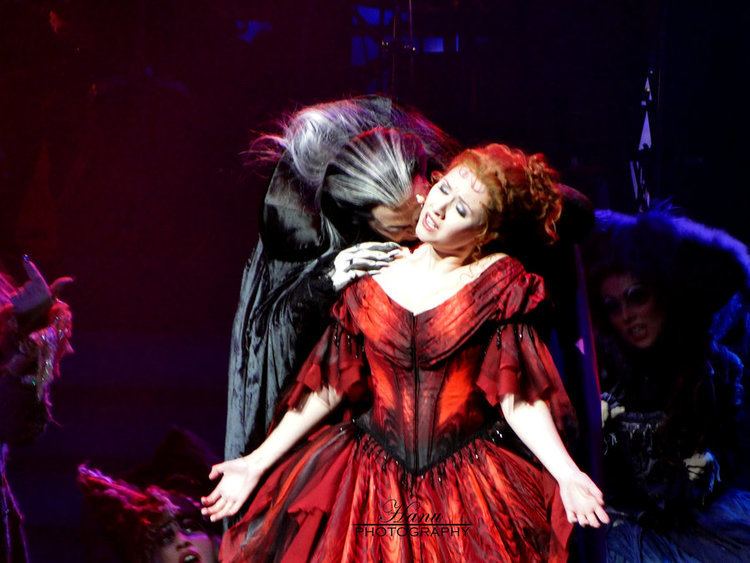 | ||
Lyrics Michael Kunze
Jim Steinman (New York)
Kirke Kangro (Tallinn)
Daniel Wyszogrodzki (Warsaw)
Miklós Tibor (Budapest)
Marika Hakola (Seinäjoki,Helsinki) Book Michael Kunze
Jim Steinman (New York)
David Ives (New York)
Miklós Tibor (Budapest) Basis 1967 Roman Polanski film, The Fearless Vampire Killers Productions 1997 Vienna
2000 Stuttgart
2000 Tallinn
2002 Broadway
2003 Hamburg
2005 Warsaw
2006 Tokyo
2006 Berlin
2007 Budapest
2008 Oberhausen
2009 Vienna Revival
2010 Stuttgart Revival
2010 Antwerpen
2011 Seinäjoki
2011 St. Petersburg
2011 Berlin Revival
2011 Nitra
2014 Paris
2016 Helsinki
2016 St. Petersburg Revival
2016 Moscow
2016 Berlin Revival Adapted from The Fearless Vampire Killers Characters Graf von Krolock, Herbert von Krolock, Professor Abronsius, Chagal, Koukol, Magda, Alfred, Sarah, Rebecca Playwrights Michael Kunze, Jim Steinman, David Ives Similar David Ives plays, Other plays | ||
Dance of the Vampires (or Tanz der Vampire as the original German language version is named) is a musical remake of a 1967 Roman Polanski film of the same name (called The Fearless Vampire Killers in the USA). Polanski also directed the original German production of this musical. Music was composed by Jim Steinman and orchestrated by Steve Margoshes, and original German book and lyrics were written by Michael Kunze.
Contents
- The dance of the vampires braver than we are and the red boots ballet
- Plot
- Act I
- Act II
- Premiere
- Tenth Anniversary Concert
- 2009 Revival
- Stuttgart
- Hamburg
- Berlin
- Oberhausen
- Estonia
- Pre opening
- Casting Crawford 911 and Other Disasters
- Previews to Opening
- Opening
- Warsaw
- Tokyo
- Budapest
- Antwerp
- Nitra
- St Petersburg
- Seinjoki
- Paris
- Helsinki
- Characters
- Songs
- Original Austrian version 1997
- Later European versions
- References
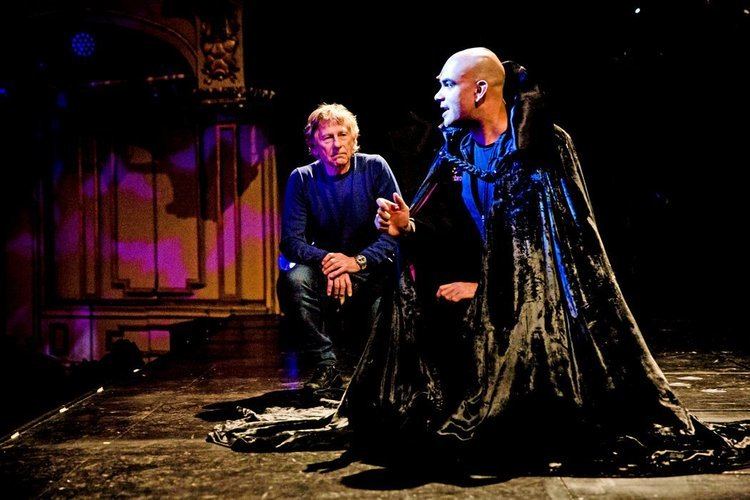
The dance of the vampires braver than we are and the red boots ballet
Plot
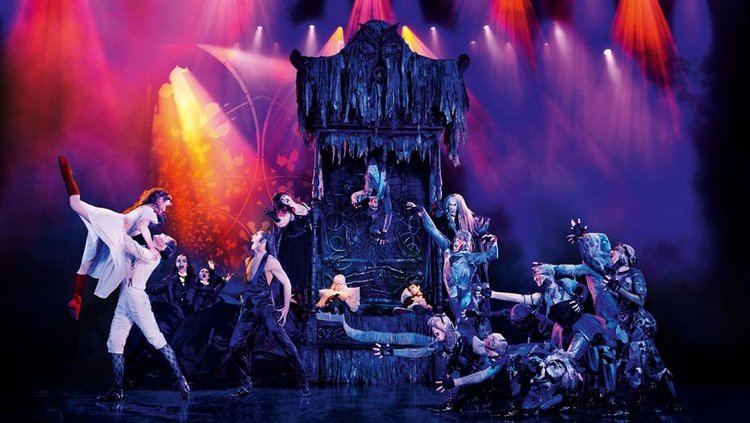
This synopsis applies to the European and Japanese productions only. The Broadway version was heavily rewritten. In addition, portions of this synopsis may reflect later changes to the European show, which will become clear when one reads the song list below.
Act I
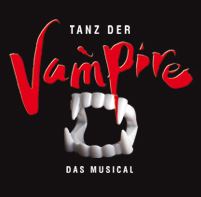
Some time in the late 19th century, Professor Abronsius and Alfred, his young but bumbling sidekick, arrive in a small Jewish shtetl somewhere in the Carpathians, where they hope to prove the Professor's theory that vampires actually do exist. Naturally, the villagers are in deep denial and refuse to confirm his beliefs. Nearly freezing to death in the nearby woods (He, Ho, He), the two are taken in by Chagal, a stereotypical Jewish inkeeper who spends most of his free time lusting after Magda, his beautiful non-Jewish chambermaid, much to the disdain of his long suffering wife, Rebecca (Knoblauch - Garlic).
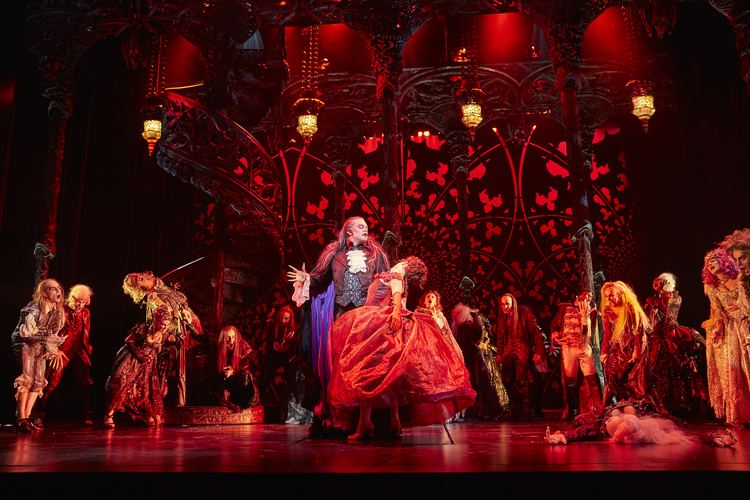
After exploring the rooms upstairs in which they are staying (Bitte, meine Herren - Please, Gentleman), Alfred discovers and is smitten by Chagal's beautiful seventeen-year-old daughter, Sarah. Chagal is very protective of his child, going as far as boarding up her room so she wouldn't bathe around the two guests (Eine schöne Tochter ist ein Segen - A Beautiful Daughter is a Blessing). That night, Alfred and Sarah sing of their mutual attraction, while Chagal does some more fooling around with the maid, and Abronsius is swiftly knocked on the head by Chagal's wife (Nie geseh'n - Never Seen). Unknown to Alfred, late at night Sarah is serenaded by a mysterious stranger, promising her eternal life and power (Gott ist tot - God is Dead).
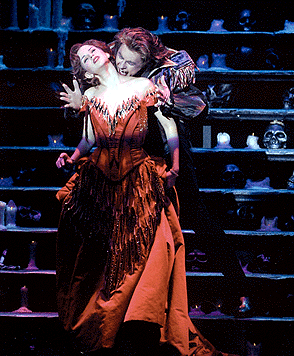
The next morning, the Professor bears witness to a small business exchange between Chagal and Koukol, a hideous hunchback living somewhere in the woods (Alles ist hell - Everything's Bright). He inquires about the odd man (Wahrheit - Truth), but Chagal refuses to discuss the matter. That same night, Sarah tricks Alfred into giving up his bath for her (Du bist wirklich sehr nett - You're Really Very Nice) and as she joyfully soaps her sponge, Count von Krolock, an aristocratic vampire breaks into the bathroom from the roof above and invites her to a midnight ball at his castle (Einladung zum Ball - Invitation to the Ball). He is about to bite the girl, but Alfred, who has been spying on Sarah's bathing ritual, screams for help. Chagal and Rebecca arrive, furious. Sarah's father spanks her and forbids her to ever go outside.
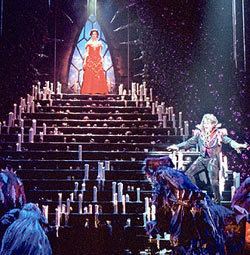
However, later that night, Koukol arrives by the inn and leaves a red bundle for Sarah on the doorstep. She sneaks outside and discovers it to be a pair of expensive red boots. Alfred comes outside as well and professes his love to her (Draußen ist Freiheit - Outside is Freedom). The two plan on running off together and Sarah asks Alfred to go back into the house to fetch her sponge. With Alfred gone, Sarah fantasizes about the fantastical, romantic vampire ball she could be missing and decides to accept the Count's invitation (Stärker als wir sind - Stronger Than We Are). She runs off into the woods. Alfred starts a panic, Chagal and Rebecca rush outside, but it's too late and Sarah's gone. Chagal wraps himself in garlic and runs into the woods after his daughter.
The next morning, Chagal's frozen body is found; Rebecca is devastated (Trauer um Chagal - Mourning For Chagal). Professor Abronsius discovers small puncture wounds all over the body, but the villagers, still in denial, assume they came from wolf bites. The Professor hands Rebecca a wooden stake and explains she must puncture Chagal's heart in order to prevent him from becoming a vampire. Hysterical, Rebecca chases him and Alfred out of the room, covering her husband with a bedsheet and swearing that she would never let anyone violate his corpse.
In the middle of the night, Magda sneaks downstairs to look at Chagal's corpse, expressing mixed feelings about his death and the sexual advances she was forced to endure while Chagal was alive (Tot zu sein ist komisch - To be Dead is Strange). Suddenly, Chagal sits up, now a vampire. Magda tries to fend him off with a crucifix, but being a Jewish vampire, he manages to overpower her and feed on her blood, killing her in the process. Alfred and the Professor sneak into the room as well, planning to stake Chagal, but they find Magda's body there instead. A chase ensues and the two finally corner Chagal, who begs for mercy and promises to show them the route to the vampire's castle where his daughter supposedly is held if he's spared.
Chagal leads the two heroes to a giant castle in the woods (Durch die Wildnis zum Schloß - Through the Wilderness to the Castle), where they are greeted by the mysterious Count von Krolock and his flamboyant son Herbert, who is instantly attracted to Alfred (Vor dem Schloß - In Front of the Castle). Von Krolock invites the two men into his domain and the two reluctantly accept his invitation.
Act II
Sarah is indeed at Count von Krolock's castle, wandering the dark empty halls and considering what her relationship with the Count truly is. The Count appears to welcome her and manages to resist biting her, planning to save her for the ball the next night (Totale Finsternis - Total Eclipse). At the same time, Alfred is asleep with the Professor in a guest bedroom in another part of the castle, suffering from terrifying nightmares in which he loses Sarah to bloodthirsty vampires (Carpe noctem).
The next morning, Alfred wants to find Sarah and flee the castle (Ein perfekter Tag / Für Sarah - A Perfect Day/For Sarah), but Professor Abronsius is more concerned with staking Von Krolock and Herbert. Alfred and the Professor make their way to the crypt (In der Gruft - In the Crypt), where they locate the two vampires. The Professor becomes stuck on a bannister as he attempts to get into the crypt and assigns Alfred to kill von Krolock and his son, but Alfred can't bring himself to drive a stake through their hearts. Before the Professor can think of something else, he hears a noise and the hapless duo flee the crypt just as Chagal arrives with Magda's coffin. Magda climbs out, now a vampire, and finally concedes to having a sexual relationship with Chagal.
Alfred and the Professor continue searching the castle and separate in the library (Bücher, Bücher - Books, Books). Alfred comes across a small bedroom where he finds Sarah in the bathroom, apparently unharmed. Alfred begs for her to leave, but Sarah refuses, saying she wants to stay for the midnight ball. She coaxes Alfred to leave the room (involving another encounter in the library, Noch mehr Bücher - Still More Books) while she gets dressed, but when Alfred returns, Sarah is gone and Herbert is in her place. Herbert tries flirting with the confused and terrified "hero" (Wenn Liebe in dir Ist - When Love is Inside You), which culminates with him lunging at Alfred's neck, but the Professor comes in the nick of time and hits the young vampire with an umbrella
As Alfred and the Professor make it outside, the sun sets and they are confronted by von Krolock, who mocks the Professor's naive attempt to destroy him (Sie irren, Professor - You're Wrong, Professor). To their horror, the two watch a whole mob of vampires rise up from a nearby church yard and head towards the ballroom (Ewigkeit - Eternity). As the vampires leave their resting places, von Krolock reflects on his painful damnation as a member of the undead (Die unstillbare Gier - The Insatiable Greed), which Alfred overhears, but the Professor dismisses von Krolock as nothing more than a monster.
The vampires arrive in the castle and the ball begins (Tanzsaal - The Dance Hall). Alfred and Professor Abronisus sneak their way inside dressed as members of the undead. Count von Krolock appears at the top of the stairs to introduce his "guest," whom he forbids the other vampires to touch. Sarah enters the ballroom in an elegant red ball gown and approaches von Krolock. He is quick to embrace her with a bite, draining her blood. The Count then proceeds to dance with the weakened Sarah as the other vampires join them in a menuet. Alfred and the Professor plan to sneak Sarah out during the dance, but unfortunately for them, a mirror is unveiled, blowing their cover since they're the only ones reflected. Von Krolock commands his vampire flock to attack Alfred and his mentor, but the former manages to form a makeshift cross out of two candelabras, causing a diversion. The three humans make their escape as von Krolock, furious, sends Koukol chasing after the girl.
Koukol chases Alfred, Sarah and the Professor through the woods, but is attacked by wolves and killed. The three heroes stop on a small hillside to rest. Alfred once more professes his love to Sarah and the two lovers embrace (Draußen ist Freiheit - Reprise - Outside is Freedom - Reprise). However, Sarah is already turned and bites Alfred mid-song, turning him into a vampire as well and both of them flee into the woods. Professor Abronsius, too consumed by his note taking, does not see what is happening behind him, until it is too late. In the epilogue, all vampires rejoice in their eternal dance. (Der Tanz der Vampire - Dance of the Vampires).
Premiere
Tanz der Vampire premiered at the Raimund Theater in Vienna, Austria, on October 4, 1997. It was produced by the Vereinigte Bühnen Wien. In 1998, it won the IMAGE AWARD for Best Musical, Best Score and Best Book. The production closed on January 15, 2000.
A complete cast recording and a highlights cast recording were made of this production.
Tenth Anniversary Concert
Tanz der Vampire returned to Vienna in February 2007. A scaled-down concert version was staged at the Raimund Theater.
A live recording was released.
2009 Revival
Tanz der Vampire opened at the Ronacher Theater on September 16, 2009. The production does not replicate the original. It features new sets, costumes, and lighting. Sets and costumes for the 2009 production were developed by Kentaur, based on the designs he developed previously for the Budapest production (see below).
Drew Sarich replaced Thomas Borchert as von Krolock on the 6th November 2010.
Stuttgart
The show had its German premiere in Stuttgart, Germany on March 31, 2000 at the Apollo Theater and closed on August 31, 2003.
2010 Revival
As a result of a public voting Tanz der Vampire returned to Stuttgart on 25 February 2010 at the Palladium Theatre.
Hamburg
A new production of the show opened on December 16, 2003, at the Neue Flora Theater in Hamburg and closed on January 22, 2006.
Notable replacements include Kevin Tarte as Krolock and Jens Janke as Abronsius.
Berlin
The Berlin production opened at the Theater des Westens on December 10, 2006 and closed on March 30, 2008.
2011 Revival
The Berlin revival, again using Roman Polanski's original 1997 staging, opened on November 14, 2011 and closed on August 25th, 2013.
Ivan Ozhogin, who originated the role of Graf Von Krolock in Russia, replaced Thomas Brochert on February 8, 2013. Ozhogin became the first Russian actor to get cast in the original German language production. In July 2012 Kai Hüsgen was replaced by Jerzy Jeszke, who played the role of Chagal various times in German productions. Barbara Raunegger was replaced by Anja Wessel in January 2013, and Amelie Dobler was replaced by Mercedesz Csampai in February 2013.
2016 Revival
Tanz Der Vampire is set to return to the Theater Des Westens on April 24, 2016 and to run through to September 25, 2016 before transferring to Munich in October 2016.
Oberhausen
The Oberhausen production opened at the Metronom Theater am Centro on November 7, 2008. The show played its final performance on January 31, 2010 before transferring to Stuttgart.
Estonia
Vampiiride Tants premiered in Tallinn on November 10, 2000 in the Tallinna Linnahall arena for a short run of 10 performances. Due to success, the show was repeated in Estonia in a concert version in 2004 with the same cast members, except for Koit Toome who was replaced by Andero Ermel. Nele-Liis Vaiksoo, who originated the role of Sarah in her native land, was to return to the show 8 years later in Oberhausen, Germany.
No official recording was released in Estonia, although the Estonian Television did broadcast most of the show, and a 5-track promotional single was released for the use of radio stations with "Öölaps" (Totale Finsternis), "Vabaks võin saada" (Draußen ist Freiheit), "Sarahle" (Für Sarah), "Laul surmast" (Tot zu sein ist komisch) and "Kaunis tütreke" (Eine schöne Tochter ist ein Segen) included.
Pre-opening
From the premiere of Tanz der Vampire, English producers were seeking to bring the show to English-speaking countries. Composer Steinman was no stranger to the theater scene in New York, having spent five years under the professional wing of New York Shakespeare Festival founder Joseph Papp in the early Seventies and authored several musicals, including The Dream Engine, Neverland and The Confidence Man, and also provided the lyrics for Andrew Lloyd Webber's musical Whistle Down the Wind. After briefly considering a West End run, under the influence of Steinman and his manager David Sonenberg, it was decided to bring the musical (now titled Dance of the Vampires) to New York for the 1998 season, with Steinman translating and reshaping the German book and lyrics, Polanski returning as director, and original Viennese producer/Polanski manager Andrew Braunsberg serving as executive producer. Efforts to return Polanski to the United States proved fruitless because of his unwillingness to face punishment for his earlier unlawful sexual intercourse with a minor, leading first to postponing the show's opening to Halloween 2000, and then to the decision (dated to roughly March 2000) to seek a different director if Polanski could not return.
In October 2000, a tentative fall 2001 opening was announced, along with the rather surprising declaration that Steinman himself would serve as the show's director, a somewhat off-putting notion due to the fact that Steinman had never directed any shows, much less one of this size and scale, in his career. Attempting to reassure doubters, Steinman asserted in interviews that "Half the show [in Vienna] I had to talk Polanski into doing, and did it behind his back a lot. He's a great guy but he had a totally different vision". As early 2001 approached, however, and a reading for potential producers and investors was announced in the news section of Steinman's fan website, things began taking on a more concrete shape. John Caird was to co-direct, and comic playwright David Ives was helping to reconfigure the book with a view toward a more comic angle instead of a straightforward adaptation of the successful Austrian version, which was deemed to be written in a style no longer accepted by Broadway critics and audiences. As Steinman later put it, looking back with a more jaundiced eye, "We were told to put five jokes on every page". Signing on as producers were Sonenberg and the producing team of Elizabeth Williams and Anita Waxman, then known for the critically acclaimed revival of The Music Man.
The new version, described by Steinman to the press as "a big, Wagnerian musical with lots of humor [...] a lot of it is pure Mel Brooks and a lot of it Anne Rice" and to the by-invitation-only audience as a musical for "people who think musicals suck," was met with a mixed reception. Potential investors and producers seemed to love the score, but felt the new book with its mix of bawdy humor and eroticism needed fine-tuning. Unfortunately, Steinman's creative disagreements with his producing team (at one point telling the press "I can't tell you how many things are the opposite of what I want, but I am part of a team"), and their seeming inability to raise the investment money in time for a now-rather-unrealistic fall opening, led to tense situations backstage. Finally Waxman and Williams were ousted from the production, with Sonenberg assuming day-to-day responsibilities as the lead producer, a strategic move viewed by many as a power grab on Steinman's part (as one source put it, "he has the final say on everything").
Casting Crawford, 9/11, and Other Disasters
At this point, the show needed some kind of drawing card to attract investors scared off by the previous snafus on the producing front. It was decided that a star lead in the role of Count von Krolock would be just the trick; feelers were put out to names as diverse as David Bowie, John Travolta, Richard Gere and Plácido Domingo. Ultimately, the team came to an agreement with Michael Crawford, best known on Broadway at the time as the lead in Andrew Lloyd Webber's The Phantom of the Opera in the 1980s. Steinman was reportedly elated, calling him "a towering talent" and "probably the biggest box-office star in the theater." However, Crawford wanted some assurances before he would take on a planned three years in the role. He demanded complete creative control of his character, he wanted a "retirement package" of up to £20m a year ($180,000 a week in American money), and he also preferred to have "first refusal" on (i.e., the option to reprise) the role in London and Los Angeles. Additionally, though not a major point in negotiations, Crawford also sought assurance that he would receive the role of von Krolock in any resulting film version, having recently lost the film role of the Phantom to initial star Antonio Banderas (later replaced by Gerard Butler). Of the four points of negotiation, Crawford won two, creative control and first refusal, eschewing the original salary (after initial press reports caused an outcry over his massive payday) for a much slimmer $30,000 a week. While Steinman, still ebullient over Crawford's casting, defended the original figure by saying Crawford "would be worth every cent we can pay him", a more sensible Crawford claimed that initial reports of a $180,000 salary were "ridiculous" and "a piece of fantasy journalism from my home country," adding that "anyone who knows how many people you can fit in a theater knows that you don't do Broadway to make money". The possibility of the film role, meanwhile, was never mentioned again.
By the time an official deal with Crawford was announced, by now downgraded to a yearlong contract in the role rather than three, he had been pulling his weight in the creative control department; as Sonenberg put it, "[He has been] working with us the last several months on input on the book." Crawford's agent Mort Viner reported that the role would not be a repeat of his Phantom performance "because of the comedy." Indeed, Crawford was involved in reshaping the role of von Krolock in a more comic fashion, insisting that the role as written was too close to the Phantom. Later reports would claim that Crawford, paranoid about doing anything that could be compared to the Phantom, agreed with the party line that the piece should be a comedy on the lines of Mel Brooks and that he personally revised and rearranged the book to that end, causing co-librettist Ives to remark that he was a stenographer rather than a writer, but in truth, the show already exhibited signs of much larger changes of a similar fashion as far back as the workshop production in mid-May 2001 before Crawford's casting; it seems that Crawford's major contributions at this time were in the vein of a "Continental accent" (a bizarre mix of Italian and Cockney tones that Crawford claimed made singing the score easier) and input on costume designs aimed at hiding alleged weight problems (jowls in particular). After rehearsals were to begin in January, the opening was set for April 2002 following six weeks of previews starting in March. Further casting sessions for secondary leads and ensemble were set for September 2001.
Due to the terrorist attacks of September 11, 2001, however, the game-plan changed in a major league fashion. With most of the show's major creative team (including co-director Caird) based in London, a myriad of logistic delays were caused by mass cancellation of flights, among other variables. Realizing there was no way to open before the Tony cut-off as planned, and (it later emerged) unable to raise his share of the investment on time, Sonenberg publicly announced the postponement of the show's opening to October 24.
Previews to Opening
Having postponed the show, the team sought to bring in additional producers who could help get the show in on time. Finally, USA Ostar Theatricals (headed by Barry Diller and Bill Haber), of the revival of Noises Off, Bob Boyett (producer of a revival of Hedda Gabler and investor in a revival of The Crucible and original productions Sweet Smell of Success and Topdog/Underdog), and Lawrence Horowitz (producer of Electra and It Ain't Nothin' But the Blues) signed on. A creative team was also finally being assembled, including set designer David Gallo, who Steinman liked because Gallo told him upon meeting for the first time that he was probably the only set designer in America who still subscribed to Heavy Metal Magazine, and that he bought Bat Out of Hell because he saw the album cover artwork (conceived by Steinman and executed by Richard Corben) and decided he had to have it before he even heard the music. On a perhaps slightly less delightful note for Steinman, due to delays caused by Caird's long-distance habitation, and a desire on the part of the new producers to see names experienced with quirky comedies at the helm, he found himself and Caird replaced as directors by John Rando of Urinetown fame, who was quickly joined by choreographer John Carrafa, his co-helmer on Urinetown.
A cast also rapidly shaped up around Crawford with the input of the new director and choreographer in a fresh set of auditions, with then-ingenues Mandy Gonzalez and Max von Essen in the young lead roles of Alfred and Sarah, Rene Auberjonois (after similar prolonged negotiations to Crawford's) as Professor Abronsius, Ron Orbach (late of the out-of-town run of The Producers) as Chagal, and Leah Hocking as Magda, among others
On paper, put together by talented people, Dance of the Vampires looked like magic. A celebrated rock composer, a critics' darling who had authored several Off-Broadway plays, a Tony-winning director, and a high-wattage Broadway star were the captains of this ship. However, rehearsals proved just how unsteady the ship actually was.
Rando had never directed a musical of this size, and quickly proved overwhelmed according to cast members. Choreographer Carrafa wasn't helping; his idea of staging a big dance number was to tell the performers, "Just rock on!" Company morale was no better, as cast members began poking fun at Crawford's weight-sensitive costumes behind his back, calling him a "fat rooster." Crawford himself was no angel either; co-author Michael Kunze attested after the fact that Crawford "reject[ed] any well-meant suggestions for change by saying 'I don't wanna talk about it anymore.'" Indeed, Kunze, the original author of the German work, had much to complain about when it came to changes, but most of all that there was no "final moment" where one concept for the production was crystallized, partly because the director didn't seem "able to decide what was good or bad about both Jim Steinman's and Michael Crawford's ideas." Adding to the lack of a definitive creative head was the director's unplanned absence, due to his mother's death, which sidelined Rando from the production during several weeks of previews. Steinman proved to have a bad attitude about the process; although publicly he put on a brave face for the press preview and for most interviews, he later claimed he could see what was wrong with the show, which he dubbed "a runaway train": "We ended up with two shows at war with each other. One was sensual and Gothic, the other was camp Rocky Horror. I knew the critics would kill us for that. We were the perfect target, a fat lady with a sign on her back that said, 'Kick me!'" However, unable to express his opinions without fighting with Crawford or the rest of the team (to the point that sharp- and quick-witted Steinman was viewed as verbally abusive by certain cast members), he opted instead to stop coming to the theater regularly, according to his account. It later emerged that in truth, presumably for his inactivity if Steinman's account is believable, Steinman was fired from the show by his own manager, acting as producer. Similarly, citing Sonenberg's inability to come up with his share of the investment, Steinman managed to get Sonenberg thrown overboard as a producer; the two did not speak for some time after the mutual firing. At about the same time, some cast members left the show, sensing that all was not well.
The show finally started previews after technological and creative delays at the Minskoff Theatre on October 18, 2002. Initially, the seemingly final result was an altered version with a lot of campy humor that differed considerably from the original show. Although the show initially went well in sales based on Crawford's name (for a time, the show played to packed houses in previews, and was in fourth place in terms of high-selling Broadway grosses without even having officially opened), the humor received some laughter and much criticism.
An attempt was made at arriving at a comfortable middle between the "two shows at war with each other," and original author Kunze was finally consulted for his opinion of what should be changed (far too late, in his view). Ultimately, thanks ironically to the German author of the original piece, the show arrived at much of its final form: during previews, 30% of the dialogue was cut to allow room to expand the score and arrive closer to the original almost sung-through concept; the vampire costumes were redesigned to look less freakish; a new staging of the shock ending set in modern times suggested by Kunze was inputted. Other suggestions, such as cutting a new dramatic death scene for the Count and restoring some of the original German lyrics, met with more dissension, and Kunze withdrew those suggestions, not wishing to cause any trouble. On a lighter note, entertainment mogul Howard Stringer, a friend of Crawford's, rang the final death knell for the weight-hiding costumes by telling Crawford he looked silly; from that point forward, the ruffled collars were gone.
Those major changes aside, the show seen in previews was still in flux, and a show that changed huge amounts of its material nightly, which caused some trouble with the cast. Crawford was regularly changing his dialogue and inserting his own jokes, testing the strength of the material, to the point that co-star Rene Auberjonois became paranoid about all of his jokes being cut, and the two of them began trying to step on each other's punchlines. By the time of opening, however, this mutual tomfoolery seemed to have been reined in; producer Bob Boyett had no complaints about Crawford's behavior, calling him "a great star and a total professional" and saying that he "didn't find him to be difficult at all." Another unfortunate side-effect of the changing material was that with Steinman out of the picture, there was no one around to write new lyrical material as necessary in some cases, and so the English version (of necessity) borrowed a lot of new material from Steinman's lyrics for the previous English versions of what songs were recycled in the show (see song list below).
Opening
After a prolonged period of development (61 previews in total, with two of the originally set opening dates missed), the English version of Dance of the Vampires opened on Broadway on December 9, 2002. Music and lyrics for the English version were officially credited to Jim Steinman, and the English book was officially credited to Jim Steinman, Michael Kunze and David Ives. This version of the show was critically lambasted; the work of lead performer Michael Crawford was reviewed particularly harshly. When the reviews came out, Jim Steinman made a show of his disapproval of the project by not attending opening night and publicly distancing himself from the show that had resulted from this "too many cooks" approach: "The show that I wrote is not at the Minskoff. The show that is dear to me is still running in Vienna (sic). The one at the Minskoff was just a job." In later days, on his blog, he would still refuse responsibility for what had occurred, writing that "DOTV as we know was UTTER SHIT!" in one post, and describing the production as a "shit pile" in another. He stated in other blog entries that his music was "wasted" on the show, and was careful to make a clear distinction between the Broadway version (referred to as DOTV) and the successful European version (referred to as Tanz).
On January 25, 2003, after 56 performances, Dance of the Vampires closed. According to The New York Times, it was "one of the costliest failures in Broadway history", losing roughly $12 million, easily eclipsing the infamous musical Carrie.
Warsaw
Taniec Wampirów opened in Warsaw at the Roma Teatr Muzyczny on October 8, 2005, using the original staging and choreography, but boasting completely new sets and costumes. The production closed on October 22, 2006 in order to avoid potential competition with the nearby Berlin production.
A highlights cast recording was released of this production.
The Original Warsaw Cast
Tokyo
The Japanese production premiered on July 7, 2006 in Tokyo.
A live cast recording was released.
The Original Japanese Cast (2006)
2009 Japanese Cast
2011 Japanese Cast
2015 Japanese Cast
Budapest
Vámpírok Bálja opened on June 30, 2007 at the Magyar Színház in Budapest. The musical was given a new visual look in the Hungarian production through the sets and costumes designed by Kentaur. The show has continued in brief runs during the summers and late December/early January each year, and the production celebrated its 150th performance on 15 January 2011.
A live cast recording was released.
(* signifies that the actor has left the production)
Antwerp
On 9 September 2010 a Flemish production opened in Antwerp, Belgium for a limited engagement after being delayed for several months due to a legal dispute over government backing of the production. The production, the first in the Dutch language, was directed by Polanski's assistant, Cornelius Baltus, who directed most of the previous and subsequent stagings of the show. Kentaur's production design was used once more in this production.
Nitra
The Slovak student production premiered on May 3, 2011 in Nitra. Directed by Peter Oravec.
The Original Slovak Cast
St. Petersburg
The Russian production of Tanz der Vampire premiered on September 3, 2011 at the "State Theater of Musical Comedy" in St. Petersburg. It is the fourth staging to utilize Kentaur's sets and costumes. The production closed on July 31, 2014.
Seinäjoki
A brand new non-replica production of Tanz der Vampire ("Vampyyrien tanssi") opened in Seinäjoki, Finland, on September 10, 2011.
Paris
In October 2013, it was announced that Tanz der Vampire would be making its French debut. Translated into Le Bal des Vampires, the show, once again directed by Roman Polanski, made its premiere at the Théâtre Mogador in Paris, France on October 16, 2014. French singer Dumè was initially cast as Comte von Krolock but, on September 2, 2014, Dumè announced his stepping out of the production due to a back injury, leading to the role being taken over by French comedian/singer and musical theatre actor Stéphane Métro. The production closed on June 28, 2015 after 203 shows.
Helsinki
A brand new non-replica production of Tanz der Vampire ("Vampyyrien tanssi") opened in Helsinki, Finland, on 3.2.2016.
Characters
(Note: Many changes in characterization were made for the Broadway version. This refers to the original European version.)
Songs
While Steinman's fans acclaim it as his biggest musical success, about 70% of the musical score written by Steinman was recycled from his earlier projects, mainly from his less-known shows like The Dream Engine and The Confidence Man (co-written with Ray Errol Fox), although it also features music from his widely known records like "Total Eclipse of the Heart" (remade as "Totale Finsternis"), the melody, but not the lyric, from a Bat Out of Hell II song called "Objects in the Rear View Mirror May Appear Closer than They Are" (remade as "Die unstillbare Gier") and "Original Sin", originally written for the Pandora's Box album of the same name and later sung by Meat Loaf in Welcome to the Neighborhood (parts of which were remade as "Gott ist Tot" and "Einladung zum Ball"). The song "Tonight Is What It Means to Be Young" from the soundtrack to the film Streets of Fire was also used (remade as "Der Tanz der Vampire").
Asked at one point to explain the reuse of "Total Eclipse", Steinman explained, "That was an accident almost. I'm surprised it stayed in. [For the original production] in Vienna, I had only a month and a half to write this whole show and we needed a big love duet... But with Total Eclipse of the Heart, I was trying to come up with a love song and I remembered I actually wrote that to be a vampire love song. Its original title was Vampires in Love because I was working on a musical of Nosferatu, the other great vampire story. If anyone listens to the lyrics, they're really like vampire lines. It's all about the darkness, the power of darkness and love's place in dark. And so I figured 'Who's ever going to know; it's Vienna!' And then it was just hard to take it out."
Asked about the impact of previously heard songs, especially Total Eclipse, on the show's popularity in Europe, Steinman replied, "Well, the reaction, at least in Europe, was great. They recognized it, but then it seems - if it's done well - to take on a different personality."
Original Austrian version (1997)
This song list also reflects the Japanese production in 2006.
Later European versions
While some song titles changed in later variations, aside from the addition of one number to replace Die roten Stiefel, the substance of the score is largely the same. (For example, the new title of Nie geseh'n merely reflects the first line of the song replacing its original title, not a new number being written. English translations of the new German phrases are provided as above, the exception being Wuscha Buscha, which is a nonsense phrase repeated in the peasant scenes in question.) The list below reflects changes made to all productions after the Stuttgart and Berlin runs. A few scenes have also been revised with shorter songs and less underscoring in order to pick up the pace of the show.
Songs
1Ouvertüre
2Knoblauch
3Eine schöne Tochter ist ein Segen
